
Catalog excerpts

Maxtec Safety Data Sheet Section 1: Identification Product Name: MAX-250 series, MAX-2, MAX-8, MAX-25 and MAX-50 Oxygen Sensors Synonyms: UN2922: Corrosive liquid, toxic, n.o.s. (Acetic acid solution, Lead acetate) CAS Number(s): 6080-56-4, 64-19-7, 127-08-2, 7439-92-1 Product Use: Oxygen Sensor Manufacturer/Supplier: Maxtec Address: 2305 South 1070 West, Salt Lake City, Utah 84119 General Information: 800-748-5355 (Toll Free), +1-801-266-5300 (International) Transportation Emergency Number: Section 2: Hazard(s) Identification Note The oxygen sensors contain a weak acidic solution encapsulated in a plastic housing. Under normal operating conditions the solution (electrolyte) is never exposed. In case of a leak please observe the following information: GHS Classification: Lead Acetate, Trihydrate Health Reproductive/Developmental – Category 1A Acetic Acid Solution Health Eye Corrosion – Category 1 Skin Corrosion – Category 1A Potassium Acetate Health Environment Physical Not a hazardous substance or mixture Lead Health Acute Toxicity – Category (inhalation) Acute Toxicity – Category 4 (oral/dermal) Carcinogenicity – Category 2 Reproductive/Developmental – Category 2 Target organ Toxicity (Repeated) – Category 2 SDS01 Rev. A Environment Acute Aquatic Toxicity – Category 1 Chronic Aquatic Toxicity – Category 1 Environment Acute Aquatic Toxicity – Category 1 Chronic Aquatic Toxicity – Category 1
Open the catalog to page 1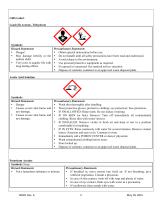
GHS Label: Lead (II) Acetate, Trihydrate Symbols: Hazard Statements • Danger! • May damage fertility or the unborn child. • Very toxic to aquatic life with long lasting effects. Precautionary Statements • Obtain special instructions before use. • Do not handle until all safety precautions have been read and understood. • Avoid release to the environment. • Use personal protective equipment as required. • If exposed or concerned: Get medical advice/ attention. • Dispose of contents/ container to an approved waste disposal plant. Acetic Acid Solution Symbols: Hazard...
Open the catalog to page 2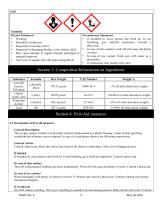
Symbols: Hazard Statements Precautionary Statements • Warning! • If breathed in, move person into fresh air. In not breathing, give artificial respiration. Consult a • Harmful if swallowed. physician. • Suspected of causing cancer. • In case of skin contact, wash off with soap and plenty • Suspected of damaging fertility or the unborn child. of water. • May cause damage to organs through prolonged or • In case of eye contact, flush eyes with water as a repeated exposure. precaution. • Very toxic to aquatic life with long lasting effects. • If swallowed, rinse mouth with water. Section 3:...
Open the catalog to page 3
a physician. 4.2 Most important symptoms and effects, both acute and delayed The most important known symptoms and effects are described in the labelling (see section 2) and/or in section 11. 4.3 Indication of any immediate medical attention and special treatment needed No data available Section 5: Fire-Fighting Measures 5.1 Extinguishing media Suitable extinguishing media Use water spray, alcohol-resistant foam, dry chemical or carbon dioxide. 5.2 Special hazards arising from the substance or mixture Carbon oxides, Lead oxides, Potassium Oxides 5.3 Advice for firefighters Wear...
Open the catalog to page 4
Section 7: Handling and Storage 7.1 Precautions for safe handling Avoid rough handling. Avoid exposing sensor(s) to rapid changes in pressure. Avoid puncturing or damaging sensor membrane(s). In case of sensor leakage see section 6. 7.2 Conditions for safe storage, including any incompatibilities Store sensors in a cool, dry and well-ventilated place. 7.3 Specific end use(s) Apart from the uses mentioned in section 1 no other specifics uses are stipulated. Section 8: Exposure Controls/Personal Protection 8.1 Control parameters Components with workplace control parameters Component CAS-No....
Open the catalog to page 5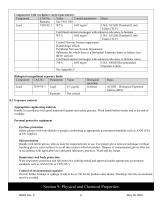
Components with workplace control parameters Component CAS-No. Value Control parameters Remarks See 1910.1025 Lead 7439-92-1 WTA 0.05 mg/m3 USA. ACGIH Threshold Limit Values (TLV) Confirmed animal carcinogen with unknown relevance to humans WTA 0.05 mg/m3 USA. ACGIH Threshold Limit Values (TLV) Central Nervous System impairment Hematologic effects Peripheral Nervous System Impairment Substance for which there is a Biological Exposure Index or Indices (see BEI® section) Confirmed animal carcinogen with unknown relevance to humans varies TWA 0.05 mg/m3 USA. NIOSH Recommended Exposure Limits...
Open the catalog to page 6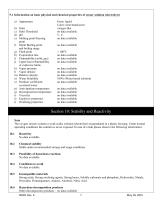
9.1 Information on basic physical and chemical properties of sensor solution (electrolyte) a) Appearance b) c) d) e) f) g) h) i) j) k) l) m) n) o) p) q) r) s) t) Odor Odor Threshold pH Melting point/freezing point Initial Boiling point and boiling range Flash point Evaporation rate Flammability (solid, gas) Upper/lower flammability or explosive limits Vapor pressure Vapor density Relative density Water Solubility Partition coefficient: n-octanol/water Auto-ignition temperature Decomposition temperature Viscosity Explosive properties Oxidizing properties Form: liquid Color: clear/translucent...
Open the catalog to page 7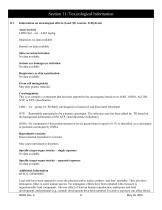
Section 11: Toxicological Information 11.1 Information on toxicological effects (Lead (II) Acetate, Trihydrate) Acute toxicity LD50 Oral – rat – 4,665 mg/kg Inhalation: no data available Dermal: no data available Skin corrosion/irritation No data available Serious eye damage/eye irritation No data available Respiratory or skin sensitization No data available Germ cell mutagenicity May alter genetic material. Carcinogenicity This is or contains a component that has been reported to be carcinogenic based on its IARC, OSHA, ACGIH, NTP, or EPA classification. IARC: 2A – group 2A: Probably...
Open the catalog to page 8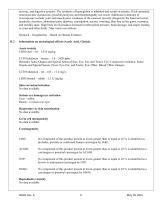
nervous, and digestive systems. The synthesis of hemoglobin is inhibited and results in anemia. If left untreated, neuromuscular dysfunction, possible paralysis, and encephalopathy can result. Additional symptoms of overexposure include: joint and muscle pain, weakness of the extensor muscles (frequently the hand and wrist), headache, dizziness, abdominal pain, diarrhea, constipation, nausea, vomiting, blue line on the gums, insomnia, and metallic taste. High body levels produce increased cerebrospinal pressure, brain damage, and stupor leading to coma and often death., May cause...
Open the catalog to page 9All Maxtec catalogs and technical brochures
-
UltraMaxO2
2 Pages
-
SmartStack Equipment Stand
2 Pages
-
Provita® I.V. Poles
2 Pages
-
MD300 C2 Pulse Oximeter
2 Pages
-
MD300 C63 Pulse Oximeter
2 Pages
-
M800 Handheld Pulse Oximeter
2 Pages
-
MaxBlend 2
2 Pages
-
MaxVenturi®
2 Pages
-
MaxFLO2 Mini Air / O2 Mixer
2 Pages
-
MicroMax
2 Pages
-
Bird® MicroBlenders
1 Pages
-
Micro Dial-Flowmeter
1 Pages
-
BlenderBuddy 2
2 Pages
-
DFB Dual Scale Flow Meters
2 Pages
-
Oxygen Flow Meters
2 Pages
-
Maxtec Acrylic Flow Meters
2 Pages
-
MaxBlend Lite
2 Pages
-
Max N2 ® +
2 Pages
-
Handi+ Scuba
2 Pages
-
MaxO2 ® +A Scuba
2 Pages
-
MaxO2 ME
2 Pages
-
Max-550E Sensors
1 Pages
-
Blender Buddy ™
2 Pages
-
MaxVenturi ®
2 Pages
-
M800
2 Pages




























